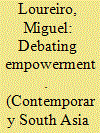| Srl | Item |
| 1 |
ID:
142474


|
|
|
|
|
| Summary/Abstract |
Many inhabitants of Azad Jammu and Kashmir (AJK) hold the belief that their society is not only more egalitarian today than that of their forefathers', but also more egalitarian than that in Pakistan. According to them, Pakistani society continues to be highly hierarchical with stark class and caste-like boundaries, while in AJK these boundaries have become weaker and merely symbolic since the 1970s due to changes in four interconnected factors; namely, migration patterns, land ownership, access to education, and democratic politics. This created an unprecedented level of social mobility among and within biradaris, the caste-like kinship corporate entities that are the crucial social boundary in this region. Yet, the main factor dictating membership in the biradari – endogamy – did not change, and access to power and resources is still determined mostly through biradari-ism. In this paper, I examine how notions of hierarchy and social stratification evolved over time and what contributed to this evolution. I argue and conclude that AJK society is still hierarchical but it has gained an element of fluidity.
|
|
|
|
|
|
|
|
|
|
|
|
|
|
|
|
| 2 |
ID:
170271


|
|
|
|
|
| Summary/Abstract |
In the aftermath of the 2005 earthquake that struck Pakistan-administered Kashmir an unprecedented number of development actors arrived in the region. Their impact influenced men’s perceptions of change in the gendered division of labour, as they claimed this arrival had increased women’s access to work in public spaces. Across urban and rural bazaars, a wide spectrum of male voices used this perceived increase to either try to further enhance women’s access or to curtail it. The struggle for women’s access to work in public spaces was visible in the stories these men told publicly. Although it pre-dated the earthquake, its aftermath made it more visible. Men’s narratives around women’s access to work post-earthquake also reflects a crisis of masculinity. The earthquake’s aftermath gave an opportunity for some men to reinforce the region’s classical patriarchy and others to challenge it; while doing so, men were also staking a claim at redefining what it meant to be a man.
|
|
|
|
|
|
|
|
|
|
|
|
|
|
|
|
| 3 |
ID:
189716


|
|
|
|
|
| Summary/Abstract |
The 2022 floods that affected 33 million people in Pakistan resulted from a confluence of factors. The nation is highly vulnerable to climate change, which requires international action. But internal governance reforms are needed to improve the state’s ability to help citizens recover from the floods and better prepare for future natural disasters. Pakistan has mismanaged its natural resources and is mired in economic and political crises. In rural areas, colonial-era patterns persist in unequal control over land and water. Though some lessons were learned from major 2010 floods, the latest disaster response revealed a need for improving coordination across different levels of government and engaging with civil society.
|
|
|
|
|
|
|
|
|
|
|
|
|
|
|
|